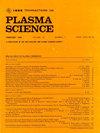Relaxation of Electric Field by Covering Cathode Edge With Vanadate Glass
IF 1.3
4区 物理与天体物理
Q3 PHYSICS, FLUIDS & PLASMAS
引用次数: 0
Abstract
The surface flashover discharge model under direct current (dc) voltage in a vacuum is considered an avalanche discharge induced according to the field emission electrons generated by the electric field concentration and secondary electron yield on the insulator surface. One of the effective ways to suppress this phenomenon is to suppress the field emission electrons at the origin. We have investigated a method for relaxing the field concentration by covering the cathode edge with metallic glass, and the following conclusions were obtained. Metallic glasses are conductive dielectrics and can be sintered to form amorphous and smooth surfaces. Covering the cathode surface with metallic glass is expected to relax the electric field concentration around the cathode edge. The metallic glass evaluated was vanadium-based, with a glass transition temperature of 321 °C, a crystallization temperature of 439 °C, a resistivity of 107–钒酸玻璃覆盖阴极边缘对电场弛豫的影响
根据电场浓度和绝缘子表面二次电子产额所产生的场发射电子,认为真空直流电压下的表面闪络放电是一种雪崩放电。抑制这种现象的有效方法之一是抑制源处的场发射电子。我们研究了用金属玻璃覆盖阴极边缘来减弱场浓度的方法,得到了以下结论。金属玻璃是导电介质,可以烧结形成无定形和光滑的表面。用金属玻璃覆盖阴极表面有望放松阴极边缘周围的电场集中。所评价的金属玻璃为钒基玻璃,玻璃化温度为321℃,结晶温度为439℃,电阻率为107 - $10^{8}~\Omega $ -cm,相对介电常数为15。在氧化铝表面形成阴极和阳极的样品,在阴极边缘有金属玻璃涂层和没有金属玻璃涂层的情况下,对其耐压进行了评估。结果表明,在10−7 Pa的超高真空条件下,薄膜的持压能力比未涂膜时提高了约2.7倍,并获得了良好的电场弛豫效应。对金属玻璃作为导电介质材料的电场浓度弛豫效应进行了数值模拟,结果表明弛豫效应与实验结果相当。未来的应用将包括实际应用,如多引脚馈线中的引脚对引脚交互。
本文章由计算机程序翻译,如有差异,请以英文原文为准。
求助全文
约1分钟内获得全文
求助全文
来源期刊

IEEE Transactions on Plasma Science
物理-物理:流体与等离子体
CiteScore
3.00
自引率
20.00%
发文量
538
审稿时长
3.8 months
期刊介绍:
The scope covers all aspects of the theory and application of plasma science. It includes the following areas: magnetohydrodynamics; thermionics and plasma diodes; basic plasma phenomena; gaseous electronics; microwave/plasma interaction; electron, ion, and plasma sources; space plasmas; intense electron and ion beams; laser-plasma interactions; plasma diagnostics; plasma chemistry and processing; solid-state plasmas; plasma heating; plasma for controlled fusion research; high energy density plasmas; industrial/commercial applications of plasma physics; plasma waves and instabilities; and high power microwave and submillimeter wave generation.
 求助内容:
求助内容: 应助结果提醒方式:
应助结果提醒方式:


